Dishwashers 60 cm
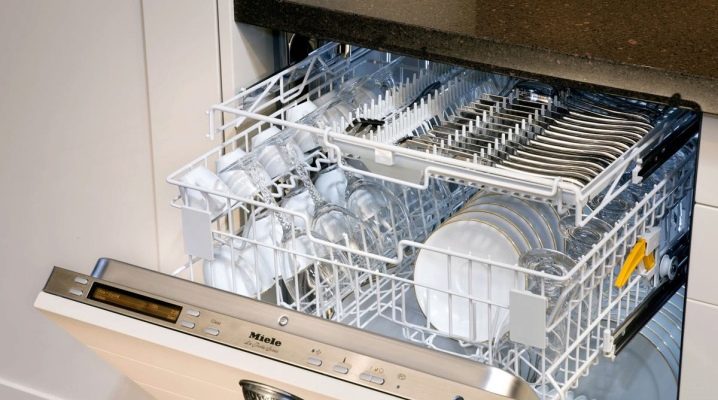
A dishwasher is a design that has completely replaced a person in such routine and unpleasant work as washing dishes. The device is widely used in public catering and at home.
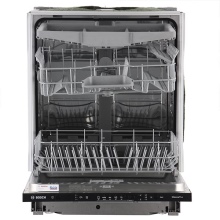

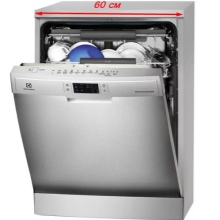
A bit of history
The first prototype dishwasher appeared in 1850 thanks to Joel Goughton, who invented an automatic dishwasher. The very first invention did not receive recognition from the public and industry, as well as professional use: the development was too "raw". The machine worked slowly, not very high quality, was unreliable. The next attempt to invent such a necessary device was made 15 years later, in 1865. Unfortunately, it also did not leave a noticeable mark in technological evolution.
In 1887, a fully operational dishwasher debuted in Chicago. Its author was Josephine Cochrane. The general public became acquainted with the miracle of design thought of that time at the 1893 World Exhibition. That car was equipped with a manual drive. Naturally, the design was strikingly different from modern descendants. The electric drive appeared later, and that unit was not intended for living conditions.
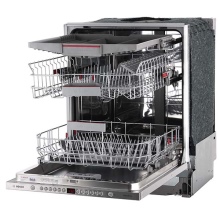
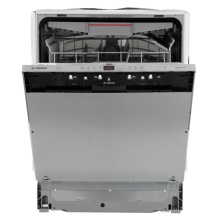
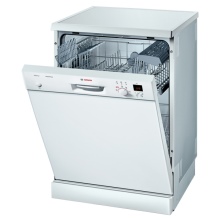
The next version of the PMM, as close as possible to modern ones in terms of functionality, was invented in 1924. This machine has a front door, a tray for placing dishes, a rotating sprayer, which decently increased its efficiency. The dryer was built much later, in 1940. Around the same time, work began in England on the organization of central water supply systems throughout the country, which made possible the domestic use of PMM.
The most interesting thing about Leavens' work is that this man was quite far from household appliances. The inventor is known as a military engineer, designer of lethal weapons, one of which, "Projector Leavens", was a gas mortar that fired shells filled with deadly gas and chemical fillings.
However, more than thirty years passed before the cost of this type of household appliances decreased so much that it became available to the mass European and American consumers. The dishwasher, manufactured in Russia, was produced at the Straum plant in Riga.
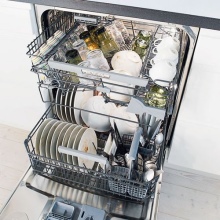

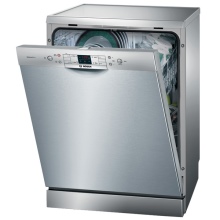
It happened back in 1976, when Latvia was still part of the USSR. Its capacity and capacity was enough for four dining sets.
Advantages and disadvantages
First, consider the benefits of PMM
- Significant time savings in the high-speed realities of today, which have a negative impact not only on the physical, but also on the emotional state. Modern society carries a lot of negativity, and upon coming home, a person is forced to do household chores, which also negatively affects the state of the nervous system.
- Like the automatic washing machine, the PMM does not need hot water, since it is equipped with heating elements - heating elements.
- The dishwasher has another extremely important parameter: it disinfects the dishes by rinsing them with boiling water. For families with small children, this feature is very useful.
- Using a dishwasher saves a person from direct contact with detergents. For allergy sufferers, who can be adversely affected even by smell, this is sometimes the only way out.

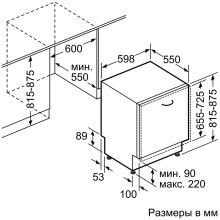
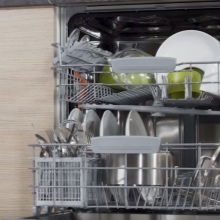
Another controversial parameter is financial savings. According to the manufacturers, the machine uses less water than the manual process, which would seem to guarantee savings. However, at the same time, PMM consumes a lot of electricity, and detergents for it will cost much more than a regular set for hand washing.
Like any man-made creation of human hands, dishwashers are not without drawbacks.
- The need for free space to accommodate a fairly large dishwasher of 60 cm.
- Full load: almost all models require this, which is not very convenient for a family of 2 people. This will require half load models.
- It's a shame, but PMM does not 100% exempt from hand washing: wooden dishes, thin glass, dishes with painting have to be washed by hand.
- The machine can hardly cope with carbon deposits and other complex dirt on metal dishes. This type of tableware also requires manual processing.
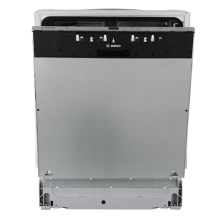
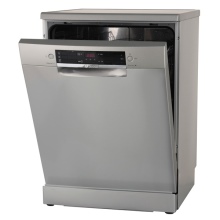
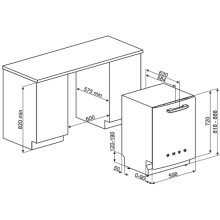
For PMM you need special detergents and emollients, regular care and considerable purchase costs.
Species overview
Dishwashers are represented on the market by the widest range. These are built-in, free-standing, compact (desktop) PMMs. Unfortunately, compact cars have smaller dimensions than standard ones with a depth of 60 cm, but two models are still present in the top.
PMMs are divided not only by size and functionality, but also by resource consumption classes. With regard to energy consumption, this indicator is marked with the letter designation "A", sometimes with pluses. "A" means low consumption, "A ++" will be better than just "A", but will yield to the "A +++" class. In addition, such equipment is also distinguished by high indicators in terms of the level of dishwashing and productivity.
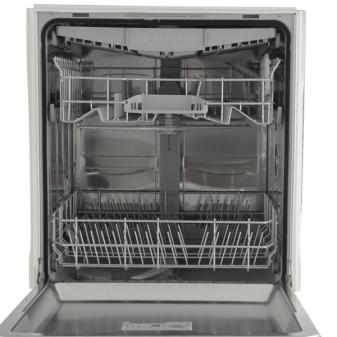
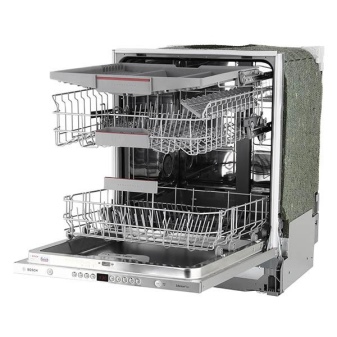
Standard dishwashers with three baskets are suitable for spacious rooms and hold a large amount of dishes, while narrow ones are preferred when the kitchen area is limited. Small, compact models with more limited dimensions can be installed on a worktop or cabinet next to the sink. All internal surfaces of the machines are made of stainless steel, since the device constantly interacts with water.
Besides, PMM can be operated with full or half load. Both the wide and narrow models are stationary devices. In contrast, tabletop dishwashers can change locations. The narrow model can be installed under the sink if the traditional siphon is replaced with a special one. Full-size and partially recessed 3-tray models can have a top open panel. Weight ranges from 17 (compact) to 60 (standard) kilograms. The heavier the structure, the quieter it works.


For example, a full-size dishwasher of the BOSCH SMV30D30RU ActiveWater brand weighs 31 kg, and the Electrolux ESF9862ROW weighs 46 kg.
Embedded
These are the most expensive premium devices. They can be installed under a worktop, leaving the control panel and door open. Or you can opt for a fully built-in model that has the same surface as the surrounding furniture. Such PMMs do not stand out in interior design in comparison with other options.
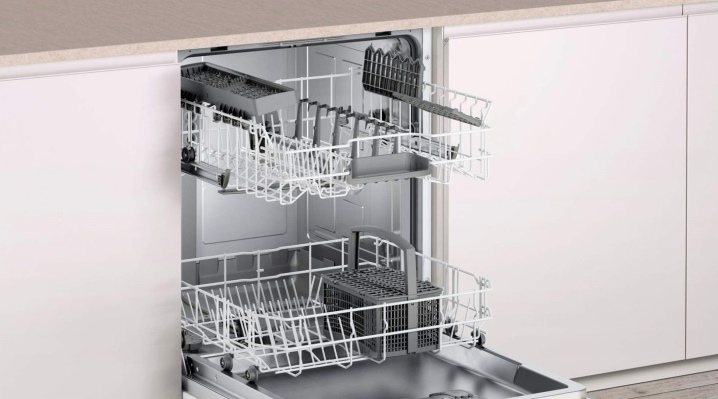
Freestanding
This type is preferred in cases where it is not possible to equip PMM inside cabinets. You can position the car anywhere, but it is necessary to take into account the dimensions of the structure, and they are very impressive. Freestanding machines fit well into a spacious room.

Desktop (compact)
This option is ideal for small apartments such as studios. Such a machine can be installed without much damage to the surrounding space: it not only fits on the table, but also fits into the large compartment of the kitchen cabinet. A compact dishwasher has clear advantages for one or two people: it can be moved, transported and even suspended. In addition, it is notable for its low price.
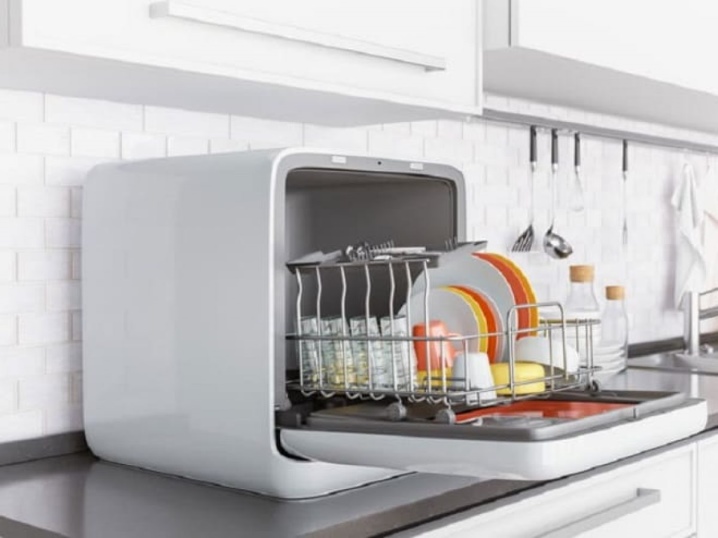
Top best models
Below is a list of the most popular models.Thanks to a wide range of products, it is always possible to choose a structure that is suitable for design, type of installation, class of resource intensity.
Let's look at the embedded options first.
- Electrolux EEA 917100 L. A very practical technique, and the dimensions and volume of the dishes to be processed make it an ideal option for a large family. Simultaneous capacity - 13 sets. Water consumption - 11 liters per cycle, energy - 1 kW / h. Silent inverter motor and electromagnetic induction delicately protect friction parts from wear, thereby extending the service life. Almost no noise during operation. Energy class - "A +", there is a delayed start function, adjustable section height. The functionality has been increased: 5 programs and 4 temperature modes. There are additional pre-soak options for heavily and lightly soiled dishes.
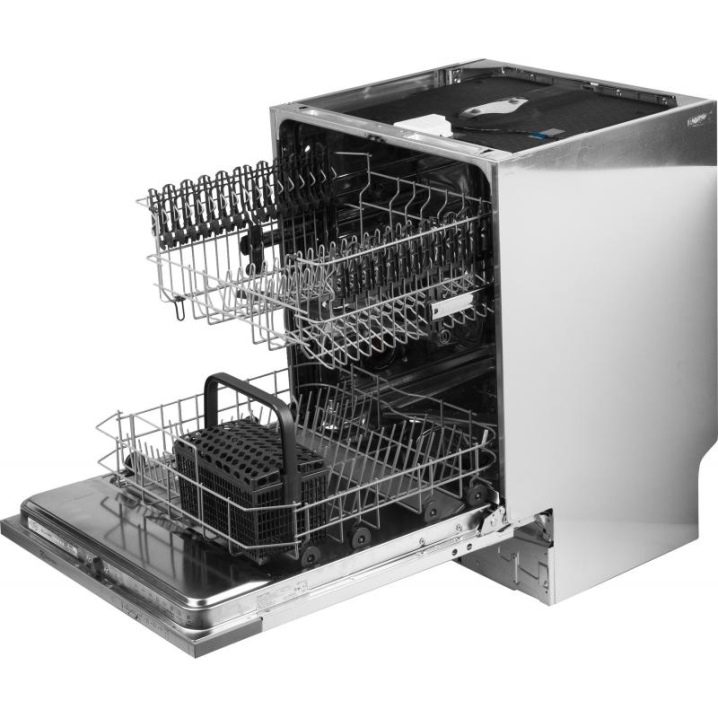
- Bosch SMV25AX01R. Full size model with child lock, electronic control and working volume for 12 sets at a time. Inverter motor, noise level - 48 dB. There are five programs, two heating modes. The increased power allows you to remove difficult dirt: dried food residues, dough, foam from the walls of dishes. Two cycles: fast and daily, glass cleaning function.

- Weissgauff BDW 6138 D. The height of the basket can be adjusted, the machine can hold 14 sets at a time, there is a beam indicator on the floor. The design provides for half load, is equipped with eight programs and four heating modes.
There is a delayed start timer, everyday and delicate options. Energy consumption class - "A ++", 2.1 kW / h, 47 dB.
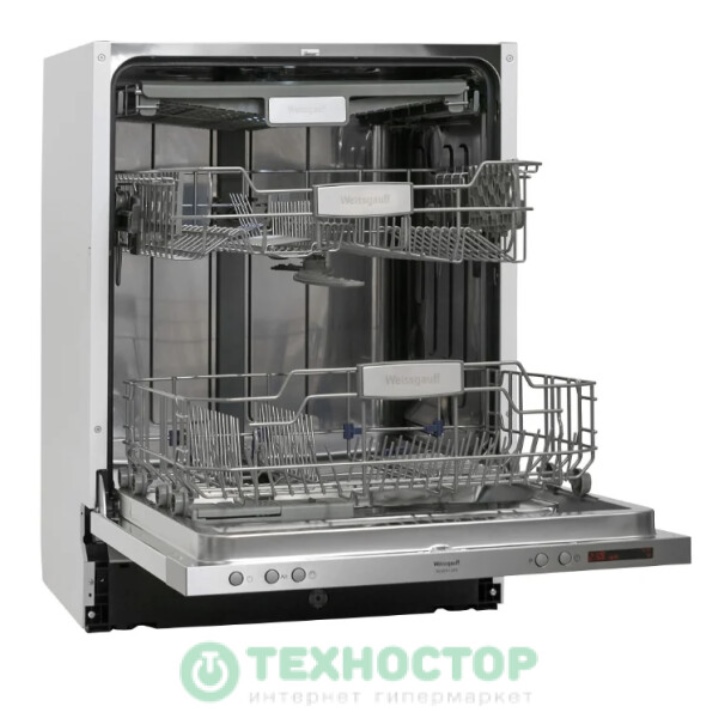
Free-standing options can also earn the trust of buyers.
- Electrolux ESF 9526 LO. The AirDry drying technology has been introduced here. PMM is equipped with an adjustable grate that can accommodate large-sized dishes, with a high degree of heating. Capacity - 13 sets, delayed activation timer is provided, after shutdown the door opens a little by 10 cm, which speeds up drying. Energy class - "A +".

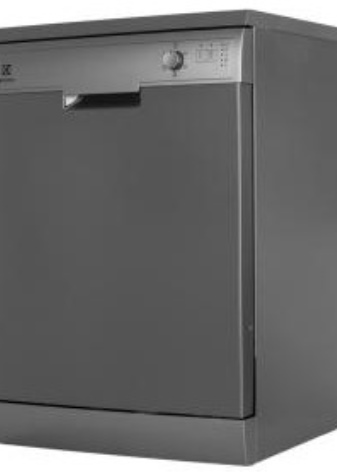
- Daewoo Electronics DDW-M1411S. It is characterized by a low price, a half load function is provided, and has a top-class drying. The inner surfaces of the model are made of stainless steel, the structure is equipped with an adjustable section for dishes, a glass holder. Six built-in programs, five heating modes, Power consumption - class "A".

- Weissgauff BDW 6138 D. Half load is allowed here, there is a stainless steel washing compartment. Capacity - 14 sets of dishes, leakage protection, adjustable section, cutlery tray, glass holder, digital panel, interior lighting, 4 temperature settings, 8 programs. In addition, there are options for soaking, intensive rinsing, express rinsing. Energy class - "A ++".
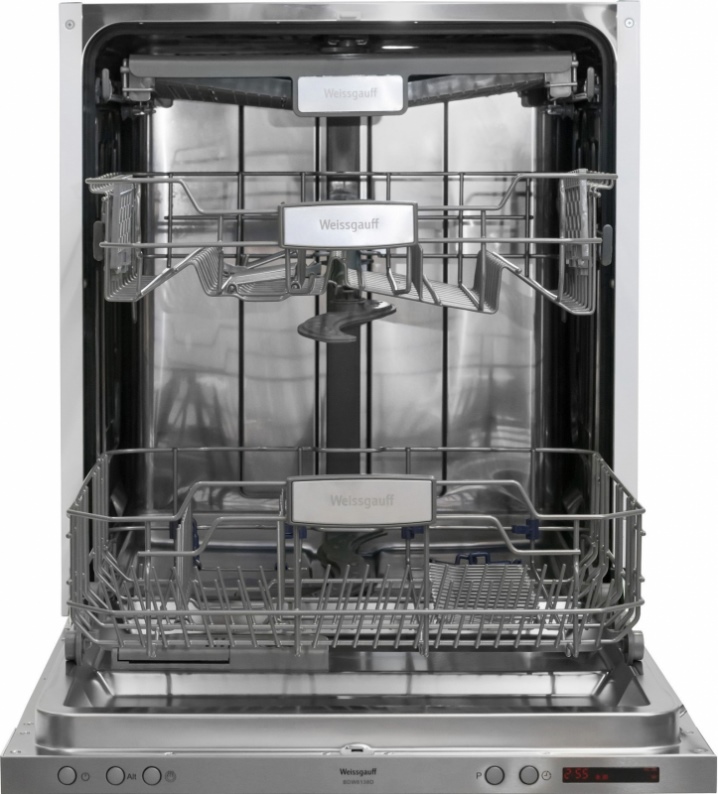
Among the compact device options, consumers particularly noted the following solutions.
- Siemens iQ500 SK 76M544. Partially built-in model, capacity - 6 sets, there is an instantaneous water heater, delayed activation and pause, six programs, protection against leaks. The machine is equipped with a turbidity sensor. The parameters are as follows: width - 60, height - 45, depth - 50 cm. There is an additional rinse option.
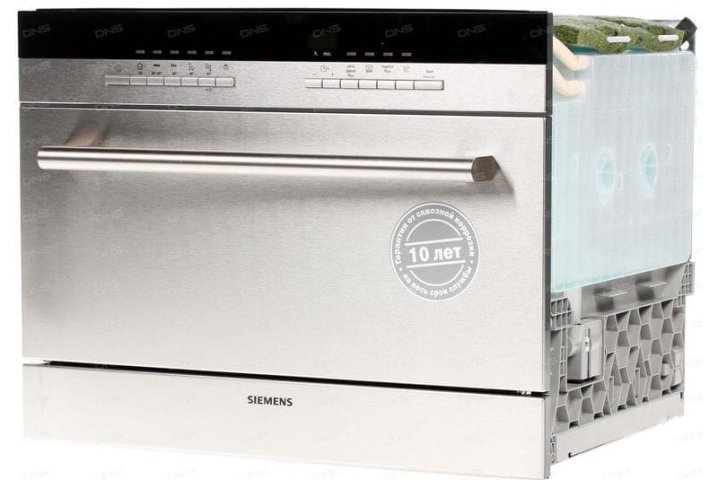
- Candy CDCF 8 / E. Dimensions - 55x59.5 cm. Tabletop PMM 55 cm deep has an increased working volume (8 sets), water consumption - 8 liters, there are 5 heating modes, process indicators, a tray for instruments, a holder for glasses. Energy class - "A". The noise level is slightly increased - 51 dB.
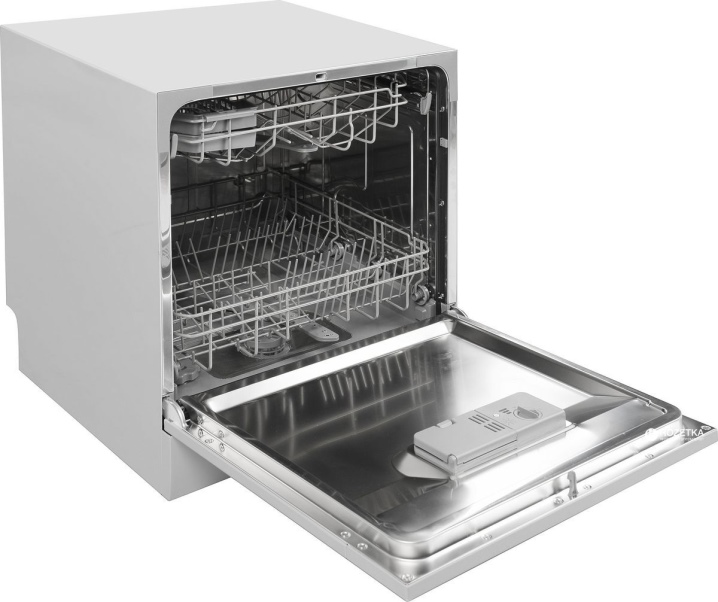
Compact tabletop dishwashers have a high rating in their segment due to their budget price, small size and mobility: the location of the structure may vary depending on the situation.
Criterias of choice
To choose a PMM for your home, you need to remember about several technical characteristics that determine the choice.
- The capacity of the PMM (how many sets of dishes the device can hold at the same time).For example, in full-size designs it will be 12-14 sets, in desktop ones - 6-8.
- Energy class. In modern machines, this is the “A” mark: an economical but powerful dishwasher with high performance.
- The water consumption specified in the technical passport of the PMM.
The average water consumption for full-size devices is 10-12 liters, in compact ones it will be much less.
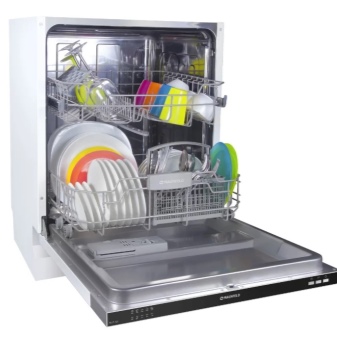
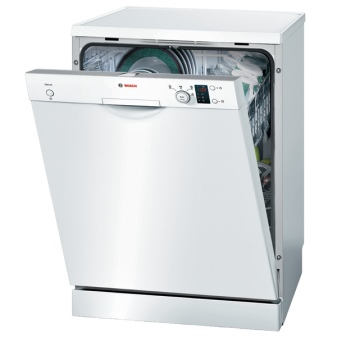
Cabinet selection and installation
There is one more important condition that you need to think about in advance. In order to install a dishwasher in a renovated kitchen, you need to find the right place for it. The first thing to do is to keep the power point close, and the outlet must:
- have indicators of moisture resistance;
- be grounded and connected through a difavtomat.
If there is no ready-made outlet, then you will have to take care of the organization of the wiring. After that, you need to think about choosing a curbstone. There are several requirements here:
- the cabinet should be located near the sink;
- so that there is no overload of the drain pump, the hose cannot exceed one and a half meters;
- the size of the niche for the PMM must be at least 5 centimeters larger than the dimensions of the machine.


Then the place for the built-in dishwasher is prepared:
- you need to adjust the height of the legs;
- find and use the fasteners that come with the PMM to ensure the stability of the structure during operation;
- stretch through the special holes and connect the hoses: the drain is connected to the siphon, the filler is connected to the water supply;
- ensure complete tightness at the joints of the FUM tape and clamps;
- connect the power supply and make a test run.
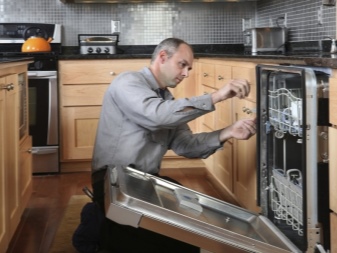

Connecting a dishwasher with your own hands is a simple process, it takes only a few hours along with organizing a working niche and then checking the quality of the work done.













The comment was sent successfully.